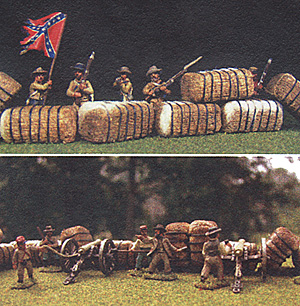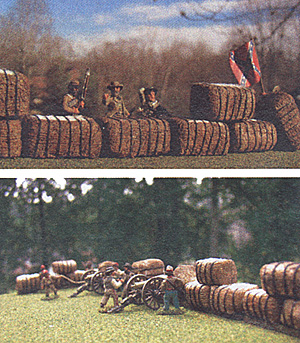 Most of us in ACW gaming are well acquainted with the Eastern theatre a battle, with fields dissected by wood fences and stonewalls. But the Civil War was fought in a thousand other places besides the popular battlefields of Virginia, Maryland and Pennsylvania. If you would like to try a different scenario, may I recommend you look to the Deep South and the Western theatre of war? There you are likely to encounter another terrain feature with unique and interesting qualities: Cotton Bales!
Most of us in ACW gaming are well acquainted with the Eastern theatre a battle, with fields dissected by wood fences and stonewalls. But the Civil War was fought in a thousand other places besides the popular battlefields of Virginia, Maryland and Pennsylvania. If you would like to try a different scenario, may I recommend you look to the Deep South and the Western theatre of war? There you are likely to encounter another terrain feature with unique and interesting qualities: Cotton Bales!
I guess Andrew Jackson deserves the credit for the idea of using cotton bales on the battlefield. At the Battle of New Orleans in 1815, Old Hickory positioned his hodge-podge force behind a barricade of cotton bales and sugar barrels, which resulted in a lopsided victory with 2,000 British casualties to the Americans' 22.
By the time the Civil War occurred, cotton was the commercial king in the South, and bales could be found on nearly every plantation, river and sea wharf, and train station. One regiment, (the 4th Alabama Infantry, Company G) had a cotton bale painted on the obverse side of their 11-star first national Confederate flag. Numerous postwar accounts recall "the cotton bale flag" at First Manassas. Cotton bales played a role in many engagements ...Vicksburg, Port Hudson, Pine Bluff, Corinth, Sherman's campaign, and Yorktown, to name a few.
On the ACW gaming battlefield, I have found cotton bales can be used for three purposes: as BREASTWORKS, as HASTY WORKS, and as a CONTRABAND OBJECTIVE.
COTTON BALES AS BREASTWORKS
"....the boys are well in good health.... we expect to stay here if not driven away by overwhelming numbers. General Fagan says if the Yankees come here he is going to fight them at all hazards. We are fortifying with cotton bales.... "
- --Capt. Wm. F. Patton, 22"d Ark. Inf. Nov 9, 1863
"The rebels had constructed a parapet along the inner bank of this bayou by using cotton bales from the plantation close by and throwing dirt over them."
- --Gen. Ulysses Grant at Vicksburg (memoirs)
 Cotton bales were a preferred resource for entrenchments and defensive barricades because a bale could absorb a Minie ball and, in some cases, even a cannonball; and they could be assembled into affordable protection with less effort than trench-digging or wooden construction.
Cotton bales were a preferred resource for entrenchments and defensive barricades because a bale could absorb a Minie ball and, in some cases, even a cannonball; and they could be assembled into affordable protection with less effort than trench-digging or wooden construction.
"Union cannon emplacements on Shorter Hill sensed they were about to loose their quarry and began firing at the steamers, but the pilots had carefully placed bales of cotton around the strategic boilers and other important parts of the boats. The cannon balls only buried themselves deep in the cotton bales and both boats escaped."
- --Newspaper report, Rome, Ga. May 17, 1864
"Moore reports his parapet too slight to resist the enemy's shot, and makes the suggestion that cotton bales be placed against the parapet on the inside, and covered with about a foot of earth. I have asked the engineer to see to these two positions as soon as possible."
- --C. S. Gen. John B. Fortney, May 29, 1863
"The line was formed under a heavy fire from the enemy, and the troops charged the (cotton bale) breastworks, carrying it instantly, killing and wounding many of the enemy by their deadly fire, as well as the bayonet. This charge was resisted by the negro portion of the enemy's force with considerable obstinacy, while the white or true Yankee portion ran like whipped curs almost as soon as the charge was ordered."
- --C. S. Gen. Ben McCulloch, June 7, 1863
On the gaming battlefield, I give bales about the same cover and concealment value as a stonewall. They provide more protection than woods or fence, but less than earthen entrenchments. As an obstacle to movement, I again compare bales to stone walls. Infantry can climb over with little reforming or disorder penalty, and period accounts cite instances of cavalry horses vaulting over bales (if single stacked) with relative ease.
COTTON BALES AS HASTY WORKS
Another advantage to cotton bales as defensive works is their mobility. A 5001b bale could easily be rolled and tumbled by three or four ablebodied men, so the bales could be quickly moved to provide defensive cover for a battle line or battery, barricade roads, and protect flanks.
"But that long roll cured me, for I was with you as soon as I could get there and it was a dark night, and I heard as I thought the booming of cannon, but it was cotton bales being rolled and thumped about, by at least a thousand men. It is wonderful how you can imagine such things, but it did sound like the battle was in full blast. That was the first cotton fort I saw..."
- --Capt. Sylvester G. Parker, 63rd Illinois Inf. Co. H
"Two or three men would get behind a bale, roll it awhile, then stop and shoot awhile. A line would be advanced in this way as close as was thought proper, and while the men lay behind and fired, a second line would be rolled up and placed on top of the first. "
- --C. S. Capt. Joseph A Wilson (memoirs)
Numerous terrain manufacturers offer cotton bale entrenchments as both finished and unfinished terrain pieces. I handcraft my own individual bales, so they can be strategically maneuvered and arranged as desired on the gaming battlefield. For movement, I detach one stand of figures (as skirmishers) to perform this task, and allow them to move one miniature bale at a time at half movement rate. This is most effective to quickly block and defend a road, bridge, or other narrow passage. The next time you watch a rerun of that classic Civil War film, "The Horse Soldiers," notice how John Wayne accurately uses cotton bales to defend his position in the "Newton Station" battle scene.
"I occupied the whole town except for the court house and yard, which was fortified by heavy and effective breastworks of cotton bales. The federals could only be captured by storming the works, which would have cost me the loss of at least 500 men. I did not think it would pay."
- --C. S. Gen. James Marmaduke, Oct. 25, 1863
Cotton bales had one serious disadvantage, however ... they would burn. A well-placed explosive artillery shot could set them afire. A stack of bales set ablaze created a long-lasting obstruction.
"When the battle come, Captain Manly carried me down to the battle ground and I stayed there til the fighting was over. I was a soldier that day ...1 didn't carry no gun nor cannon. I carried water from the river for to put out the fire in the cotton bales what made the breastworks. Every time the `federates shoot, the cotton, it comes on fire. "
- --Slave narrative, Arkansas
"The handful of convalescent Confederate soldiers took charge of the home guard and placed them behind the breastworks of cotton bales. The Bridge Street bridge was filled with bales and saturated with turpentine so it could be fired in case of defeat."
- --John Wisdom, Confederate stage driver & spy, May 31, 1863
COTTON BALES AS AN OBJECTIVE
As the war continued on and on, the lack of available manpower caused the cotton crops to diminish. Cotton became a scarce commodity and bales nearly worth their weight in gold. A cache of bales was a highly sought prize by invading Union armies. The retreating Confederates were equally motivated to hide them or, as a desperate last choice, destroy cotton bales to deny them to the enemy.
Mr. Stanton:- DEAR SIR: The mania for sudden fortunes made in cotton ... has to an alarming extent corrupted and demoralized the army. Every colonel, captain, or quartermaster is in secret partnership with some operator in cotton; every soldier dreams of adding a bale of cotton to his monthly pay...."
- --Charles A Dana, Memphis, Jan 21, 1863
"The best I recollect the Yankees come in here `bout July.... and us could hear the cannons 15 miles off. Then they would make trips out foraging for stuff, corn and such, and they would take all the cotton they could find. Our men, they would hide the cotton in the thickets and canebrakes iffen they had time or either they would burn it up before the Yankees come if they could...
Bout that time the Yankees arrive and say don't you burn that cotton and they looked all over the place and find the bales that was hid in the woods."
- --Slave Narrative, Arkansas
The situation became totally absurd when cotton bales were sold to Union troops to get supplies for the Confederate army. Even President Lincoln allowed foodstuffs to be sent to Lee's troops at Petersburg in exchange for cotton for northern textile mills. Grant stopped this exchange because he was attempting to cut off Lee's supplies and hasten the end of the war.
"It so happened that these people had cotton, and whenever they apprehended our large armies would move, they destroyed the cotton in the belief that, of course, we would seize it, and convert it to our use. They did not and could not dream that we would pay money for it. It had been condemned to destruction by their own acknowledged government, and was therefore lost to their people..."
- --William T. Sherman (memoirs)
In several "what if" gaming scenarios, we have given a meager Confederate force possession of a cache of bales, and a 3 times numerically superior Union force attempting to capture it. Major victory for the Rebs will be to survive and maintain possession of the bales, minor victory if they have to burn it and flee. Northern major victory is achieved if they eliminate the defending force and capture the cotton bales intact; minor victory if they force the Confederates to surrender but see their prize go up in smoke. It is a delicate quandary for the Union side if the Rebs use the bales as defensive works... the Union artillery must refrain or risk burning up their objective!
Cotton bales were part of the Christmas gift Sherman sent to President Lincoln in his now famous telegram:
"I beg to present you as a Christmas gift, the city of Savannah, with 100 and fifty guns and plenty of ammunition, also about 25,000 bales of cotton. "
- --William T. Sherman, Dec. 22, 1864
Back to Table of Contents -- Charge! # 6
Back to Charge! List of Issues
Back to MagWeb Master Magazine List
© Copyright 2005 by Scott Mingus.
This article appears in MagWeb.com (Magazine Web) on the Internet World Wide Web.
Other articles from military history and related magazines are available at http://www.magweb.com